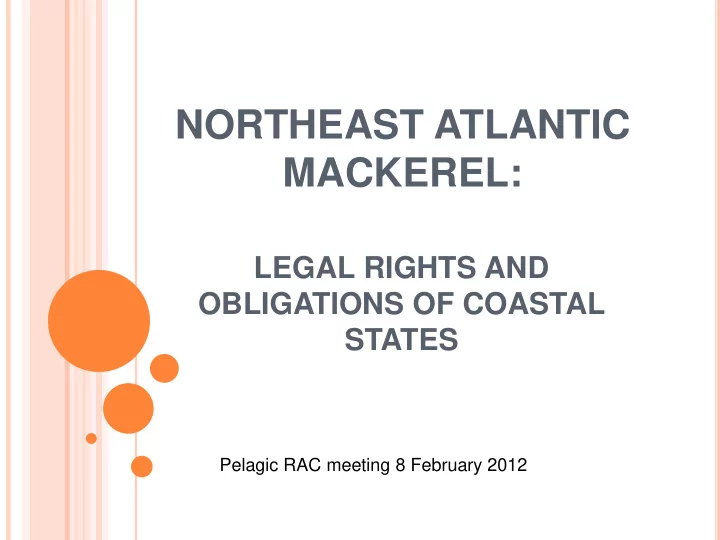

NORTHEAST ATLANTIC MACKEREL: LEGAL RIGHTS AND OBLIGATIONS OF COASTAL STATES Pelagic RAC meeting 8 February 2012
OUTLINE Classification under international law 1. Rights and duties under the Law of the Sea 2. Convention Key principles prescribed in the Fish Stocks 3. Agreement The role of NEAFC regarding the mackerel controversy 4. Bilateral/multilateral agreements between the coastal 5. States Settlement of disputes 6. Concluding remarks 7.
CLASSIFICATION UNDER INTERNATIONAL LAW Range of distribution includes maritime zones of: ① The EU ② Norway ③ Iceland ④ Faroe Islands Classification: Transboundary fish stock = moves between the EEZ a) boundaries of the above coastal States Straddling fish stock = appears also in high seas b)
LAW OF THE SEA CONVENTION: DUTIES Of conservation and management: Ensure that fish stock is not endangered by 1. overexploitation = harvesting cannot be beyond MSY. Establish TAC in accordance with the above 2. requirement. Of cooperation: Coordination of measures between the coastal 1. States in which the stock occurs. To be done directly or through regional 2. organizations
LAW OF THE SEA CONVENTION: RIGTHS Regarding conservation and management: Wide discretion in terms of: 1. What measures they adopt a. The TAC they decide to establish b. Regarding cooperation: Obligation is of conduct, not of result = coastal States are not obliged to reach an agreement
THE FISH STOCKS AGREEMENT: OVERVIEW Scope of application: Primarily: high seas Many crucial provisions applicable to areas within national jurisdiction = coastal States have to comply with most of the key principles of the Agreement. Coastal States have to ensure that: They do not establish TACs beyond MSY 1. They apply the precautionary principle 2. Measures guarantee long-term sustainability of the 3. stock / prevent over-fishing
THE FISH STOCKS AGREEMENT: COMPATIBILITY OF MEASURES Aim: compatibility of conservation / management measures for the entire stock and in line with the key principles Process: Agreement between coastal States, importantly regarding the overall TAC and its allocation Pending agreement: effort to enter into “provisional arrangements” If unable they can make use of the dispute settlement procedures
PROBLEMS ENCOUNTERED BY COASTAL STATES 1. No uniform interpretation: a) Bottom-up approach b) Top-down approach No preference between any set of measures c) 1. No explicit provisions establishing: a) How to perform the balancing act between equally valid, competing claims b) Priority among the different conditions to be taken into account
THE ROLE OF NEAFC Competence: relates primarily to fisheries conducted in the high seas Regarding coastal States’ EEZ: Commission may make recommendations if: The coastal State in question so requests The recommendation is accepted by that coastal State Consequence = Commission is effectively unable to suggest or impose conservation / management measures for a coastal State’s EEZ. Amendment unlikely
BILATERAL / MULTILATERAL AGREEMENTS At present: no four-party agreement covering the entire mackerel stock EU / Norway: Arrangement in 2010: Is binding between these two states for 10 years Allocates the TAC as between the parties Takes into account a future four-party agreement Trilateral (EU/Norway/Faroe Islands) arrangement for 2009: Limited in scope and time Long-term management plan? Unresolved issues
SETTLEMENT OF DISPUTES Part XV of the LOSC: comprehensive system entailing binding decisions by an International Court or Tribunal Applicable also to disputes relating to the FSA However: important exceptions: Disputes relating to a coastal State’s discretionary power to establish the TAC (only conciliation = not legally binding) Effect = hybrid procedure: Issues related to measures in the high seas: legally binding a) decisions can be adopted by Court/Tribunal Issues related to measures in the EEZ: non-legally binding b) recommendations can be adopted by conciliation commission Possible legally binding interpretation regarding c) compatibility of conservation measures
TRADE SANCTIONS? EU, Norway and Iceland = WTO members = bound by GATT. Trade restrictions (e.g. landing / import ban) allowed only under exceptional circumstances, such as: When necessary to protect human, animal or plant life or health Measure cannot be: Unjustifiable / arbitrary discrimination Disguised restriction on international trade Specialized dispute settlement procedure: Report by Panel Appellate Body Report
CONCLUDING REMARKS (1) TAC for mackerel stock cannot be set beyond scientific (ICES) recommendations. Violation of international law? Extremely difficult to prove that it is attributable to a particular coastal State given: Wide discretionary powers of coastal States in their 1. EEZ No legally-binding method of challenging such 2. discretionary powers No guidance / priority criteria regarding the distribution 3. of an overall TAC
CONCLUDING REMARKS (2) OPTIONS? Negotiation 1. Voluntary submission to dispute settlement 2. procedure entailing binding decision Conciliation procedure 3. Dispute settlement procedure regarding 4. interpretation of the FSA Amendment to NEAFC Convention 5.
THANK YOU!
Recommend
More recommend